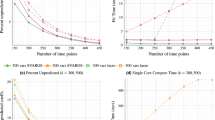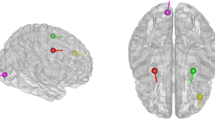Abstract
Multivariate Autoregressive time series models (MAR) are an increasingly used tool for exploring functional connectivity in Neuroimaging. They provide the framework for analyzing the Granger Causality of a given brain region on others. In this article, we shall limit our attention to linear MAR models, in which a set of matrices of autoregressive coefficients A k (k = 1, …, p) describe the dependence of present values of the image on lagged values of its past. Methods for estimating the A k and determining which elements that are zero are well-known and are the basis for directed measures of influence. However, to date, MAR models are limited in the number of time series they can handle, forcing the a priori selection of a (small) number of voxels or regions of interest for analysis. This ignores the full spatio-temporal nature of functional brain data which are, in fact, collections of time series sampled over an underlying continuous spatial manifold—the brain. A fully spatio-temporal MAR models (ST-MAR) is developed within the framework of functional data analysis. For spatial data, each row of a matrix A k is the influence field of a given voxel. A Bayesian ST-MAR model is specified in which the influence fields for all voxels are required to vary smoothly over space. This requirement is enforced by penalizing the spatial roughness of the influence fields. This roughness is calculated with a discrete version of the spatial Laplacian operator. A massive reduction in dimensionality of computations is achieved via the singular value decomposition, making an interactive exploration of the model feasible. Use of the model is illustrated with an fMRI time series that was gathered concurrently with EEG in order to analyze the origin of resting brain rhythms.
Similar content being viewed by others
References
Baccala, L. A. and Sameshima, K. (2001). Partial direc-ted coherence:a new concept in neural structure determination. Biological Cybernetics 84, 463–474.
Bernasconi, C. and Konig, P. (1999). On the directionality of cortical interactions studied by structural analysis of electrophysiological recordings. Biological Cybernetics 81, 199–210.
Bressler, S. L., Ding, M. Z., and Yang, W. M. (1999). Investigation of cooperative cortical dynamics by multivariate autoregressive modeling of event-related local field potentials. Neurocomputing 26–7, 625–631.
Brown, P.J., Fearn, T., and Vannucci, M. (1999). The choice of variables in multivariate regression: A non-conjugate Bayesian decision theory approach. Biometrika, 86, 635–648.
Brown, P.J., Vannucci, M., and Fearn, T. (2002). Bayes model averaging with selection of regressors. J. Royal Stat. Soc. Series B-Statistical Methodol. 64, 519–536.
Buchel, C. and Friston, K. (2000). Assessing interactions among neuronal systems using functional neuroimaging. Neural Networks 13, 871–882.
Buchel, C. and Friston, K. (2001). Interactions among neuronal systems assessed with functional neuroimaging. Revue Neurologique 157, 807–815.
Dahlhaus, R. (2000). Graphical interaction models for multivariate time series. Metrika 51, 157–172.
Dahlhaus, R., Eichler, M., and Sandkuhler, J. (1997). Identification of synaptic connections in neural ensembles by graphical models. J. Neurosci. Methods 77, 93–107.
Dawid, A. P. (1981). Some Matrix-Variate Distribution-Theory—Notational considerations and a Bayesian application. Biometrika 68, 265–274.
Efron, B. (1986). Jackknife, bootstrap and other resampling methods in regression-analysis—Discussion. Annals Stat. 14, 1301–1304.
Freiwald, W. A., Valdes, P., Bosch, J., Biscay, R., Jimenez, J. C., Rodriguez, L. M. et al. (1999). Testing non-linearity and directedness of interactions between neural groups in the macaque inferotemporal cortex. J. Neurosci. Methods 94, 105–119.
Friston, K., Phillips, J., Chawla, D., and Buchel, C. (1999). Revealing interactions among brain systems with nonlinear PCA. Human Brain Mapping 8, 92–97.
Friston, K. J. (1994). Functional and effective connectivity in neuroimaging: a synthesis. Human Brain Mapping 2, 56–78.
Gersch, W. and Yonemoto, J. (1977). Parametric time-series models for multivariate EEG analysis. Comp. Biomed. Res. 10, 113–125.
Geweke, J. (1982). Measurement of linear-dependence and feedback between multiple time-series. J. Amer. Stat. Assoc. 77, 304–313.
Geweke, J. F. (1984). Measures of conditional linear-dependence and feedback between time-series. J. Amer. Stat. Assoc. 79, 907–915.
Goldman, R., Stern, J., Engel, J., and Cohen, M. (2001). Tomographic mapping of alpha rhythm using simultaneous EEG/fMRI. Neuroimage 13, S1291.
Goldman, R. I., Stern, J. M., Engel, J., and Cohen, M. S. (2002). Simultaneous EEG and fMRI of the alpha rhythm. Neuroreport 13, 2487–2492.
Golub, G. H., Heath, M., and Wahba, G. (1979). Generalized cross-validation as a method for choosing a good ridge parameter. Technometrics 21, 215–223.
Granger, C. W. J. (1969). Investigating causal relations by econometric models and cross- spectral methods. Econometrica 37, 414.
Hansen, P.C. (1999). Regularization tools version 3.0 for Matlab 5.2. Numerical Algorithms 20, 195–196.
Harrison, L., Penny, W. D., and Friston, K. (2003). Multivariate autoregressive modeling of fMRI time series. Neuroimage 19, 1477–1491.
Hesse, W., Moller, E., Arnold, M., and Schack, B. (2003). The use of time-variant EEG Granger causality for inspecting directed interdependencies of neural assemblies. J. Neurosci. Methods 124, 27–44.
Hosoya, Y. (1991). The decomposition and measurement of the interdependency between 2nd-order stationary-processes. Prob. Theory Related Fields, 88, 429–444.
Kaminski, M., Ding, M. Z., Truccolo, W. A., and Bressler, S. L. (2001). Evaluating causal relations in neural systems:Granger causality, directed transfer function and statistical assessment of significance. Biological Cybernetics 85, 145–157.
Kitagawa, G. and Gersch, W. (1985). A smoothness priors time-varying Ar coefficient modeling of nonstationary covariance time-series. IEEE Transactions on Automatic Control 30, 48–56.
Kustra, R. and Strother, S. (2001). Penalized discriminant analysis of [O-15]-water PET brain images with prediction error selection of smoothness and regularization hyperparameters. IEEE Transactions on Medical Imaging 20, 376–387.
Lee, L., Harrison, L. M., and Mechelli, A. (2003). A report of the functional connectivity workshop, Dusseldorf 2002. Neuroimage 19, 457–465.
Mardia, K. V., Goodall, C., Redfern, E., and Alonso, F. J. (1998). The Kriged Kalman filter - rejoinder. Test 7, 277–285.
Martinez-Montes, E., Valdes-Sosa, P., Miwakeichi, F., Goldman, R., and Cohen, M. Concurrent EEG/fMRI Analysis by Multi-way Partial Least Squares. Neuroimage, (in press).
McIntosh, A. R. and Gonzalez-Lima, F. (1994). Structural equation modeling and its applications to network analysis in functional brain imaging. Human Brain Mapping 2, 2–22.
McKeown, M. J., Makeig, S., Brown, G. G., Jung, T. P., Kindermann, S. S., Bell, A. J. et al. (1998). Analysis of fMRI data by blind separation into independent spatial components. Human Brain Mapping 6, 160–188.
Minka, T. (2000). Bayesian linear regression. http://www.stat.cmu.edu/∼minka/papers/learning.html [Online]. Available at: http://web.media.mit.edu/∼tpminka/papers/linear.html
Neumaier, A. and Schneider, T. (2001). Estimation of parameters and eigenmodes of multivariate autoregressive models. Acm Transactions on Mathematical Software 27, 27–57.
Pearl, J. (1998). Graphs, causality, and structural equation models. Sociol Methods Res. 27, 226–284.
Penny, W. D. and Roberts, S. J. (2002). Bayesian multivariate autoregressive models with structured priors. IEEE Proceedings—Vision Image and Signal Processing, 149, 33–41.
Purdon, P. L., Solo, V., Weisskoff, R. M., and Brown, E. N. (2001). Locally regularized spatiotemporal modeling and model comparison for functional MRI. Neuroimage 14, 912–923.
Ramsay, J. O. and Dalzell, C. J. (1991). Some tools for functional data-analysis. J. Royal Stat. Soc. Series B- Methodol. 53, 539–572.
Ramsay, J. O. and Silverman, B. W. (1997). Functional Data Analysis. Springer.
Ruchkin, D. S., John, E. R., and Villegas, J. (1964). Analysis of average evoked potentials making use of least mean square techniques. Annals NY Acad. Sci. 115, 799.
Schiessl, I., Stetter, M., Mayhew, J. E. W., McLoughlin, N., Lund, J. S., and Obermayer, K. (2000). Blind signal separation from optical imaging recordings with extended spatial decorrelation. IEEE Transactions on Biomedical Engineering 47, 573–577.
Schneider, T. and Neumaier, A. (2001). Algorithm 808: ARfit—A matlab package for the estimation of parameters and eigenmodes of multivariate autoregressive models. Acm Trans. Math. Software 27, 58–65.
Stroud, J. R., Muller, P., and Sanso, B. (2001). Dynamic models for spatiotemporal data. J. Royal Stat. Soc. Series B-Stat. Methodol. 63, 673–689.
Valdés, P., Riera, J., and Casanova, R. (2000). Spatio Temporal Distributed Inverse Solutions. In Biomag 96: Proceedings of the Tenth International Conference on Biomagnetism. (Aine C. J., Y. Okada, G. Stroink, S. J. Swithenby, and Wood, C. C., eds.), Springer Verlag.
West, M. (2002). Bayesian Factor Regression Models in the “Large p, Small n” Paradigm. Working Papers of the Institute of Statistics and Decision Science, Duke University [Online]. ftp.isds.duke.edu/Working Papers/02-12.pdf
Wikle, C. K. and Cressie, N. (1999). A dimension-reduced approach to space-time Kalman filtering. Biometrika 86, 815–829.
Worsley, K. J., Marrett, S., Neelin, P., Vandal, A. C., Friston, K. J., and Evans, A. C. (1996). A unified statistical approach for determining significant signals in images of cerebral activation. Human Brain Mapping, 4,58–73.
Author information
Authors and Affiliations
Rights and permissions
About this article
Cite this article
Valdes-Sosa, P.A. Spatio-temporal autoregressive models defined over brain manifolds. Neuroinform 2, 239–250 (2004). https://doi.org/10.1385/NI:2:2:239
Issue Date:
DOI: https://doi.org/10.1385/NI:2:2:239




